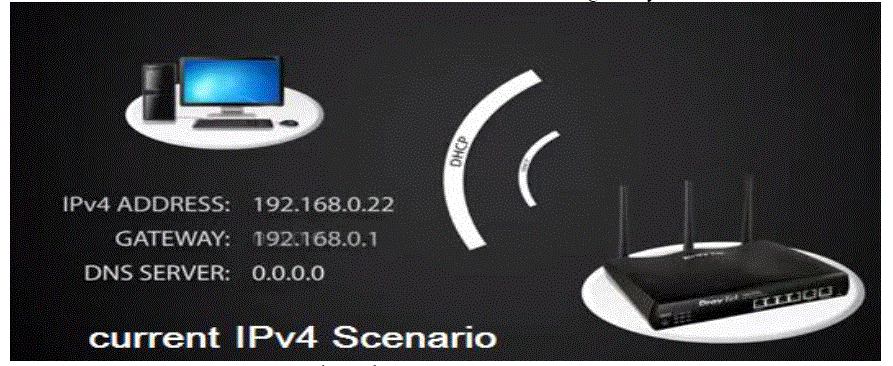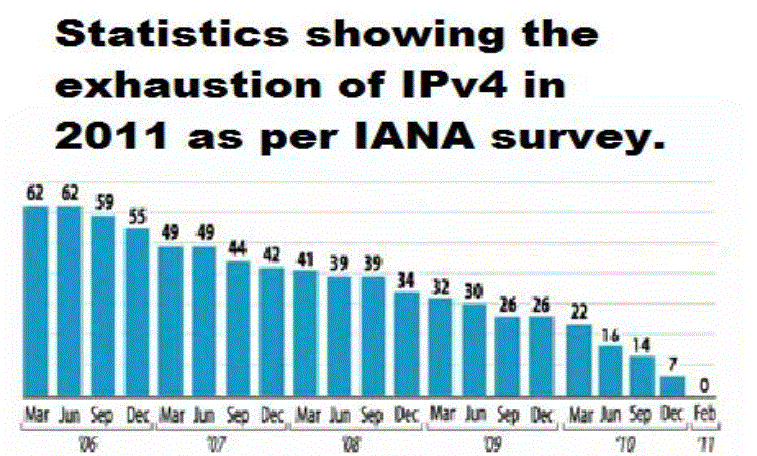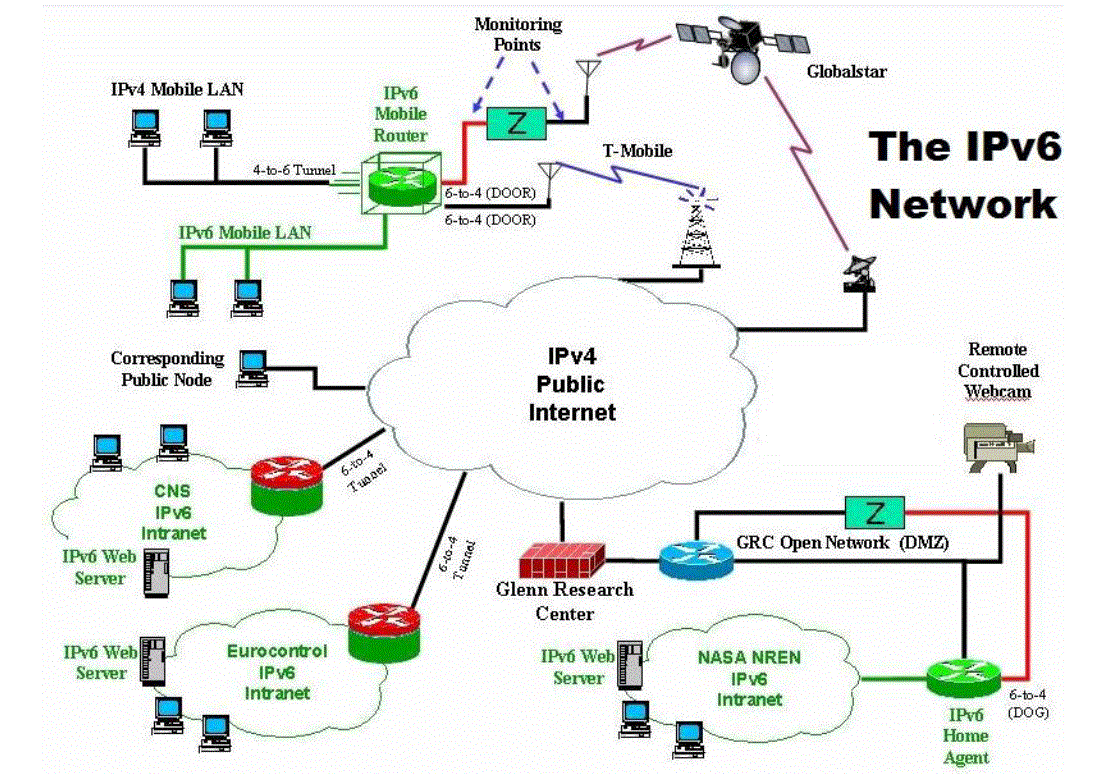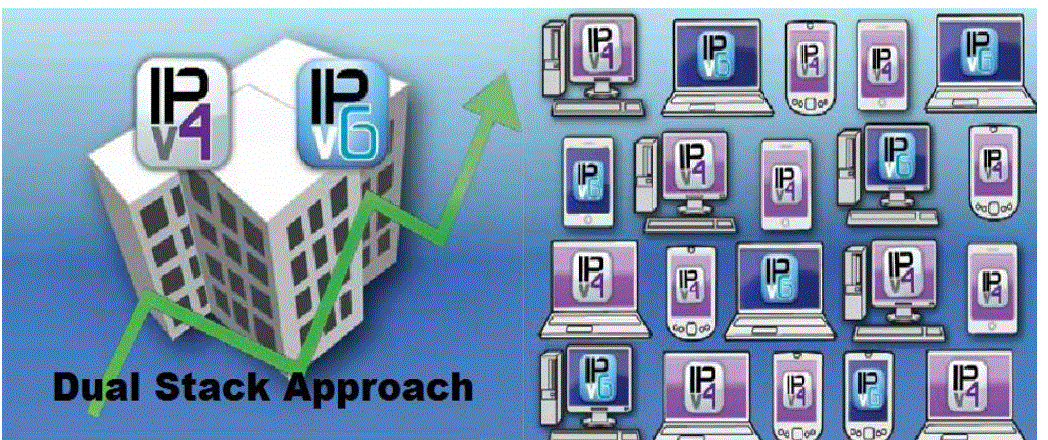Keywords
|
| IPv4, IPv6, transition, deployment, dual stack, tunnelling. |
INTRODUCTION
|
| In developed countries like United States, Japan, Korea etc, businesses are one of the moving forces by which technology advances and various standards are created. This means the latest upcoming technologies are utilized to take complete competitive advantages. In business communication Internet plays a vital role and it must use certain standards which are also followed by different client based or partner companies; else there might be some compatible issues. With the advent of standardization, an office employee would be able to login to go through his e-mails at home. And thereby will have the access to the network of the company he works using the same various available standard protocols. Now, these could be translated or redistributed to various different standard protocols to form any kind of network and hence establish a VPN tunnel. In order to get these particular standards implemented, we would also require the basic standardization of the IP addresses, which is quite imperative. By this, the packets would actually know about their final destination, hence will be correctly directed. IPv4 and IPv6 are two of such kind. The concept behind these standards is to impart some unified method by which the things can be done. And the users need not require checking or testing the various compatible issues, or go through the IP protocols when working on their projects with the client company. Consequently they should not require talking to the employees of their IT department in order to resolve the various compatible issues which might occur while communication. In this paper I am going to emphasize on the importance of Standards like ipv4 and its transition to ipv6. Thereby it’s a recital investigation which would explore the basic effects in the major business oriented areas of the world and how one is affected when it switches to altogether a new standard. And it is a massive undertaking to express IPv6 all over the world. In the present era scenario it has become utmost importance to remain up to date so as to advance in business competition. One of the major networks which would help all the users in making all sorts of worthy communication is IPv6 protocol. This paper will also list out all the major differences in the working prospect of IPv4 and IPv6. |
LIMITATIONS OF IPV4
|
| With the rapid growth of the usage of Internet all over the world in different fields and areas of businesses, research, education, and communication, Internet’s IP addresses start to run out. There had been many countries which have been significantly affected and had already been into a situation where the foremost constrained is of limited amount of IP addresses. Recent survey by the members of IETF, the alarming bells of the soon extinction of IPv4 addresses is heard. IPv4 address space is expected to run out soon. In one of the recent IEEE conferences it was revealed that Central Allocation Authority has provided the last block of IP addresses in February 2011. |
| And in the year 2013, the fact that we come across, generally every Internet based journal, states that “71 percent of the world is not yet connected to the Internet.” With the depletion of IPv4, Internet is left with no option other than IPv6. IPv4 contains 32 bits address, which is composed of host and network. These depend on different addresses classes like A, B, C, D or E. with this the total number of IP addresses which can be assigned by IPv4 is 4 294 967 296. |
| Originally, the above mentioned network classes were used for addressing. Later the address space was depleted and eventually smaller allocations were generated using Classless Inter-Domain Routing (CIDR). As per the tasks are being handled, this allocation proved to be unbalanced among various nations and organizations worldwide. Renumbering, another very important process required to perform by the users through manual configuration. In this there is a possibility of exception of DHCP. And this becomes a difficult and troublesome process mainly for a site or organisation to avoid. On the other hand, in case of IPv6, Renumbering is a prominent architectural element. Its deployment is largely automatic specifically within per 48 prefix. And from here the quest for new Internet Protocol arises. |
| This figure illustrates the statistics of IPv4 protocol as per the reports of IANA. |
IPV6 –THE NEW PROTOCOL
|
| IPv6 is although not a new term. But when it comes for the implementation process, it do becomes new especially for a country like India which a fast growing population. IPv6 is simply the upgraded version of IPv4, and makes all the attempts to overcome the drawback of the previous 4 version of Internet Protocol. Today we need an end to end more pervasive connectivity. And the fact is “We Are Not Paying Attention to This.” At one end we are at the dawn of revolution of Internet able connected devices. And this is also true, “We want always to be connected.” We want to have multiple personas on this connected Infrastructure. For instance, cloud infrastructure which is always running and always connected. Next we are at the dawn of “Sensor Network”, which in order to work more timely, robustly and efficiently, we actually require end to end connectivity. Hence we got to wake up and understand the various traffic issues which have to be face in case of IPv4 and soon adapt the IPv6 technology. Logically speaking, it is all about mathematics. There is simply no room to grow IPv4. The only growth, the only way, to come out of this is the v6 side. |
| Defence Research and Engineering Network, an ISP in United States and Enterprises like Spawar (Navy), a reputed governmental organization and Bechtel, large noteworthy Enterprise, to name a few, have adapted to such a network, where IPv6 is enabled since past over ten years. One of the big advantages of IPv6 over IPv4 is of the addressability. Suppose a firm wants to access the information from different locations by the means of cameras. Now in order to make this happen all these cameras will require a separate IP address so that they can be accessed from distant areas. Problem arises over here. Huge organizations need more IP addresses. IPv4 fails to fulfil this imperative need. IPv6 was basically developed by learning from the past mistakes. Hard work has been contributed from a group of scientists and the foremost basic requirement was addressed. We have a larger address space which can be allocated to the different vendors and users so that they can accomplish the desired factors of their respective firm. Global addresses can be generated and work can be carried on without any pause. Internet became a critical Infrastructure. Work was being done to realize the vision of the future and hence to bring end to end security as well while fulfilling the need of IP addressing. So it is all about being able to be connected anytime, anywhere and any place which could meet all the requirements of the corporate world. One very important factor that has to be kept in mind while deploying IPv6 in any organization is that IPv6 is not only about the technical advantages. There are a couple of main implementations of the IPv6 protocol. Any organization working on or planning to work on IPv6 must consider its business contexts. Because, at the end of the day, any transformation is about business continuity. It is all about ensuring that you are present on the new Internet. This can be understood here by the example of FAX. Earlier Fax was the mean to share the information. It is just a revolution how we moved from Fax to Internet. And when we talk of IPv6, question is asked, “Where you want to be?” and you have to choose one of these answer “Part of this transformation and walk with the revolution” OR “Stuck with the old fax machines”. You got to figure it out by yourself. We need to build a transition mechanism, which allows the price for co-existence. Without this there is no way we can actually transform where we want to be from where we are. So this transition mechanism from IPv4 to IPv6 is absolutely fundamental. So IPv6 is not only flexible, but also holds lower network administration costs. Auto configuration and hierarchical addressing makes network easier to manage and at same time they reduce down the costs. It is optimized for next generation networks. Because it has almost unlimited address space which allows seamless connectivity, peer to peer model for mobile communications and mobility solutions. So far your investment is concerned, IPv6 transition mechanism enable phase deployment. It will cost more to convert later as reactive urgent projects cost more and rarely go well. |
| Apart from above mentioned benefits, there are a number of operational advantages. And the most basic one is making the surety, no matter what, your data and information will flow in a secure and pervasive manner. With the help of IPv6 transition, you can make your rapid growth which may sound beneficial with all the third party providing solutions. In the military and government programs, IPv6 provides unified security architecture over the network. It also provides mobile connectivity via mobile IPv6 support for effective operations. In the Education sectors, it provides a secure and a reliable network which results in easy network management and configuration. In case of large Enterprises, IPv6 deploy a secure network for protecting confidential data and assets. It also improves the productivity via mobile connectivity. Here too, managing the network is easy as compared to IPv4. |
| Recent study dictates that there are many commercially available IPv6 products in the market. Some of which are: Array Networks, BalanceNG V3, Coyote Point Systems Equalizer, Exceliance Aloha, IBM Websphere Application Server Load Balancer 6.1, Microsoft PortProxy, Microsoft Windows Server 2008 Network Load Balancing(NLB), Radware AppDirector 2.20, Rackspace.com Cloud Load Balancers etc. Your Internet edge is the logical area to focus your initial IPv6 efforts. That’s where you have Internet Connectivity, authoritative DNS, web servers, Email and Internet-facing applications. While not fully matured in all the different areas, IPv6 is ready for prime time. So far the security and performance of IPv6 is concerned, it is equivalent to IPv4. And the prime thing to keep in mind is that, the overall deployment cost of IPv6 is not costly, as many entrepreneurs have in their thoughts. If you start early and use incremental approach, and use the tech refresh, there is almost no cost to deployment. If you procrastinate it will be costly. And if you have not started, you may be too late. |
| Today many service providers and service vendors have very limited IPv6 support functionality. Consequently you may be required to switch your providers or products. But the good part is that many of the mainstream routers/ switch products and the major operating systems all have a good support for IPv6. Another very important aspect is people tend to make many mistakes as coming from IPv4 mindset. They need to understand that it is a dual stack protocol, which requires no set of tunnels and no translators. |
| The papers which I have gone through while doing this dissertation work, the other mistake which reflected in the deployment of IPv6 is the IN-OUT mechanism. People generally make the changes in the internal network of the organization and then link it with the network of outside world. This is not only expensive, but complex as well. The appropriate remedy to which I came across is the OUT-IN way. Entrepreneurs should first analyse the requirements of their company and give a worth thought of how it would link with the outside world. Keeping this in mind they should frame the internal network which is basically according to the requirements of the company. Hence focus on the public facing services. |
| John Curran, President and CEO of American Registry for Internet Numbers, said “If you want to have the best connectivity possible for your website, you need to be connected by both IPv4 and IPv6. If you are not, new customers won’t be able to access your website.” Hence there is an urgent need to enable the public interest in IPv6 as soon as possible. Do not make your customers suffer the pain of translators in the path to your site. |
World IPv6 Day
|
| World IPv6 Day was last observed on 8th June 2011 from 00:00 to 23:59 hours. Google, Facebook, Yahoo!, Akamai, all the Limelight networks participated. This demonstrated that the engineering and operation of IPv6 on large scale is truly possible. Many of those participated, are still running IPv6 today. Some did turn it off too. Although since then, the total number of sites, turning IPv6 on permanently continues to grow. From February 6 to February 12, 2012, IPv6 International week was celebrated, where many entrepreneurs participated from all over the world. 1st January 2013 too was also observed as World IPv6 Day. |
| One of the recent news stated that, now many broadband providers are going to deploy IPv6 and their clients can make the use of it. Some of which are Comcast, Time Warner Cable. Comcast started the market deployments in November 2012 and continues to roll out dual-stack IPv6 throughout 2013. Time Warner Cable expects to have production consumer and business IPv6 services available in the first quarter of 2013. |
| The Consumer Electronics Association has started a working group on Ipv6 in august 2011. As a result we shall see many IPv6 consumer enabled devices like Blue-Ray Players; Internet enabled TVs etc by the end of this year. |
| As mentioned earlier, mass people representing their firm are into the illusion of the heavy task which needs to be implemented while doing the transition from IPv4 to IPv6. But they being very native in IPv6 are wrong. IPv6 is not difficult to implement. To support this there had been much online training available. Many consultancies and vendor supported resources are also available for paid engagements. In addition to this there are many practical examples, books, slides and reports of deployment are widely available online which could be thoroughly gone though before starting the deployment. |
| Time to time there are IPv6 Summit held every three to six months. You can be a part of those conferences, present your views, ask your queries, and learn the new section of innovation. |
TRANSITION AND DEPLOYMENT OF IPV6
|
| Scientists and Engineers are working since 1993 on the next generation protocol. Finally in 1999, IPv6, was completed, tested and was available for production with huge number of address spaces. Today, every single person on this planet can nearly own 18 million IP addresses. Consequently, there would be no need to upgrade this. Unless IPv6 is deployed on wide scale, Internet expansion and innovation might be limited and complex to manage. Use and management of IPv6 is similar to IPv4, but it is not backwards compatible. Hence, IPv6 will eventually replace IPv4 in a decade time or so. So till that time, already deployed IPv4 needs to be operational. The major approach that can be implemented here is of the dual stack, by which it would be possible for the devices to support both the Internet Protocol versions. |
| So deployment of IPv6 basically depends on the different type of services you want for your clients. Naturally, any client wants to access everything on the Internet without any disruptions. There are multiple transition technologies available. ISPs must determine to connect business using both IPv4 and IPv6. Secondly, the Content Providers must upgrade their capabilities to include IPv6 access to different services. |
| They should not wait for the people to begin asking questions like, why they cannot visit a particular website, or send e-mails. |
| Here comes the basic implementation of “dual stack concept”. With the help of which the simultaneous communication can be held between IPv4 and IPv6 enabled devices. The Application Developers must ensure that all the new products launched every now and then, should be IPv6 enabled. The softwares should work efficiently with either network protocol to meet the imperative needs of their clients. The Equipment Vendors, who generally distribute the network capable hardware devices and software products to support them, must make sure that they too can have the interaction with the IPv6 world. There is an urgent need to introduce IPv6 support in the product cycle as soon as possible. |
| Next, the Government Organizations play an important role to promote IPv6 awareness. They can coordinate with the industry, create incentives and promote IPv6 adoption. By officially adopting the v6 version and hence implementing it into their procurement policies and their network infrastructure, Government can convey a strong message to corporate and ensure services remain available. |
| In dual stack method, the hosts and routers are equipped with both IPv4 and IPv6 protocols stack in their operating systems. Your web servers need to be both IPv4 and IPv6 address configured. |
| And with this the clients can send and receive the data packets belonging to both the protocols, although IPv6 routing is completely different from v4 routing. Also, IPv6 addresses could be mapped to IPv4 using NAT. And the best part is that in pure IPv6 implementations there is no NAT, there is no DHCP, and there is no Sub netting. |
| There are many staff training organisations and institutions like ARIN’s IPv6 wiki, ISOC, NANOG etc which provide more enhance and practical knowledge to implement IPv6 in a company. |
| Tunnelling is another process by which the transition can be performed and deployment of IPv6 can be done. |
| With the concept of tunnelling, a “virtual link” between the two IPv6 nodes can be established. With the help of this link, the data packets as payloads can be transmitted. One of these nodes encapsulates the original data packet received from the node of other side. And then it forwards the generated tunnel packets through the tunnel. The other node decapsulates the received tunnel packets. Then it forwards the resulting original packet to its desired destination. Encapsulator node is tunnel entry point node and decapsulator is the exit point. Although this process of tunnelling is not much in use. |
CONCLUSION
|
| “Better late than never” is important saying which applies to IPv6 deployment and transition. The current statistics are in front of us. We have to be smarter enough to adapt this innovation as soon as possible. Although it may take a decade to fully convert the current IP system, still attempts can be made in higher numbers to be a part of this transition. Change is not coming; it is happening now. There is an utmost need to save the Internet and continue our services on the network. Deployment of the Ipv6 needs to be considered so that the basic issue of network IP addresses is overcome. |
ACKNOWLEDGMENT
|
| I take this opportunity to express my profound sense of gratitude and respect to all those who helped me throughout this research work. I acknowledge the effort of those who have contributed significantly to my work. |
| I feel privileged to offer my sincere thanks and deep sense of gratitude to Mrs. Savita Shivani Associate Professor at Suresh Gyan Vihar University, for expressing her confidence in me by letting me work on a project of this magnitude and providing her support, help & encouragement in implementing this work whenever needed. |
| |
Figures at a glance
|
 |
 |
 |
 |
| Figure 1 |
Figure 2 |
Figure 3 |
Figure 4 |
 |
 |
 |
| Figure 5 |
Figure 6 |
Figure 7 |
|
| |
References
|
- Govil , Jivesh., Kaur N. AND Kaur, H, “An examination of IPv4 and IPv6 networks : Constraints and various transition mechanisms,”, IEEE International Conference Southeastcon pp.175-185, 2008.
- AlJa'afreh, R “Implementation of IPv4/IPv6 BDMS Translation Mechanism”, Computer Modeling and Simulation,. EMS '08. Second UKSIM European Symposium, pp.512-517, 2008.
- Waixi Liu, Gao Ying; Tang Dong, “One Novel Method for NAT-PT of IPv4/IPv6 Translator”, Communication Systems and Network Technologies (CSNT), International Conference, pp.412-414, 2012.
- S Narayan,P.R Lutui;K Vijayakumar;S Sodhi, “Performance analysis of networks with IPv4 and IPv6,” Computational Intelligence and Computing Research (ICCIC), IEEE International Conference, pp.1-4, 2012.
- S Narayan, “Application layer network performance analysis of IPv4 and IPv6 on Windows operating systems”, Computers and Devices for Communication, CODEC, 4th International Conference, pp.1-4, 2009.
- Jiang Xie., “Performance Analysis of Mobility Support in IPv4/IPv6 Mixed Wireless Networks”, Vehicular Technology, IEEE Transactions on knowledge and Data Engineering, pp.962-973, Feb 2010.
|